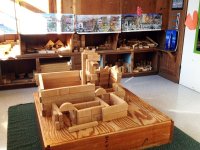Lessons in School Design from Crow Island Elementary
Designed to foster child-centered, progressive education, this public elementary school feels as fresh and inviting today as when the doors opened in 1940.
Your content has been saved!
Go to My Saved Content.What messages does your school building convey to the children and teachers who spend their days there? Does the architecture set the stage for engaging learning experiences that will prepare students for future challenges? Or are constant work-arounds required to make room for collaboration, creativity, and real-world problem solving?
An increasing number of communities are confronting these questions as they prepare to update or replace outdated school facilities. Almost half of today's public schools were built for baby boomers, at a time when the prevailing design was desks in neat rows, teacher at front of classroom. The national price tag for modernizing or replacing these factory-model school facilities is estimated at $270 billion, according to Report Card for America's Infrastructure.
It's a daunting challenge, to be sure. But there's also an opportunity here to reimagine learning environments to better meet the needs of today's students and future generations.
To advance this conversation, the American Architectural Foundation recently convened the fourth National Summit on School Design. Fittingly, this gathering of architects, educators, technologists, and policymakers kicked off discussions at an historic landmark that continues to set the standard for forward-thinking school design.
Welcome to Crow Island: "Philosophy in Brick"
Crow Island Elementary School in Winnetka, Illinois, is a public school celebrating its 75th anniversary this year. Designed to foster child-centered, progressive education in the tradition of John Dewey, the historic landmark building feels as fresh and inviting today as when the doors opened in 1940.
Classrooms are L-shaped, each with a workroom area where long-term projects can unfold (an early version of today's makerspaces). Expansive windows flood classrooms with natural light and frame views of Crow Island Woods, an outdoor learning lab that inspires inquiry and wonder. Every class has a door to its own exterior courtyard, taking learning beyond the school walls. Everything's kid-sized, with tools for learning and creating within easy reach.
The details of this building speak volumes about attention to children, such as the rounded corners on brick hallway pillars and whimsical animal sculptures on the exterior. Wood paneling has withstood decades of stapling, keeping student work on display. In the auditorium, benches get smaller as you approach the front of the room so that even the littlest feet can reach the floor.
Beth Hebert, a former Crow Island principal who led a tour during the recent summit, says the building speaks to children. "It says, 'This is for you. We knew you were coming.'"
For educators, the school affords flexibility. "The space offers suggestions -- you make it what you want," Hebert says. She typically began each day as principal in the expansive entry area, greeting children as they walked in the doors. "It's a sacred trust," Hebert says. "We're invited to use this space for good." Working at Crow Island "shaped me as a school leader," she says.
Collaborative Design in Action
Nothing about this learning environment was accidental. Crow Island came about through deliberate collaboration between educators and architects, using a user-centered design process that remains relevant today.
In the late 1930s, with the Depression continuing, then-Superintendent Carleton Washburne dared to dream. He wanted a school for his community that would embody the ideas of John Dewey. He wanted teachers to be designers of child-centered, experiential learning, not implementers of canned curriculum. This clear vision preceded the design process.
Before architect Lawrence Perkins (whose firm later became Perkins + Will) made a single sketch, he spent months sitting in other Winnetka classrooms. He watched children and teachers interact with their environments and listened to them talk about learning. The Crow Island design was further informed through collaboration with the renowned father-son architects, Eliel and Eero Saarinen.
The result was a school designed "from the inside out" to serve students, teachers, and the community. Unanticipated needs -- such as technology integration -- have been accommodated without major renovations. Other than the addition of a new wing (with the same classroom layout), the school's only major addition since 1940 has been a resource room/media center in the basement.
Shaping the Future
Communities across the country can draw lessons from the Crow Island example as they embark on their own school design projects. For starters, engage educators in the design process.
Ron Bogle, president and CEO of the American Architectural Foundation, points out that U.S. school districts spend $14 billion per year to renovate, design, and build new facilities. "If we are to create next-generation schools, it is essential that educators have greater influence in co-creating the learning environments which support their education vision," he said. Bogle shared insights about the role of design in learning at the first-ever White House Summit on Next Generation High Schools in November.
AAF's Design for Learning program is currently working with six districts across the country to transform schools into 21st-century learning environments that will advance STEM education and foster more personalized learning. Although projects vary from community to community, three strategies guide the work, Bogle says. First, a community needs to be ready for disruption. Second, design thinking offers a process to engage educators and architects as co-creators and builds common ground for collaboration. Third, change management strategies ensure lasting results.
AAF will release its report about the National Summit on School Design in early 2016. Watch for more posts in the coming months about ongoing efforts to transform spaces for learning.
